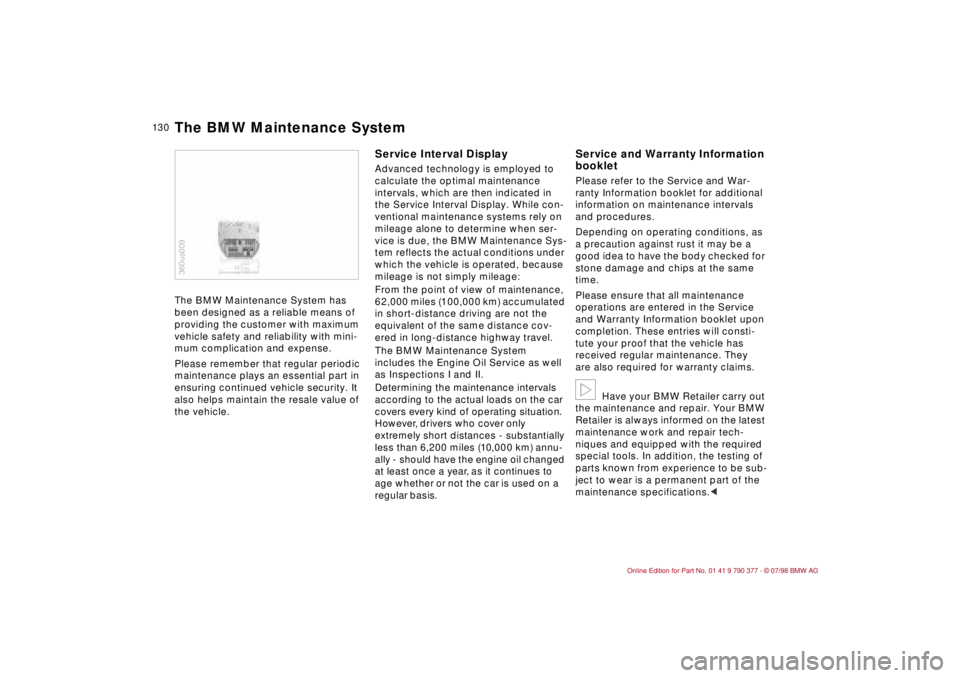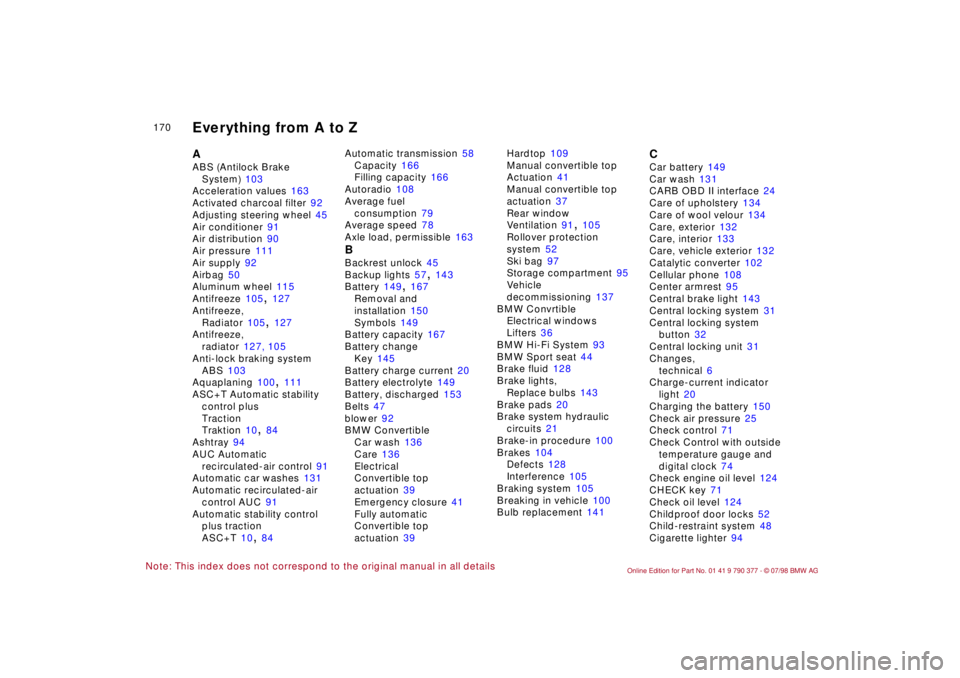1998 BMW CONVERTIBLE air condition
[x] Cancel search: air conditionPage 104 of 179

10 3
At a glanceControlsCar careRepairsTechnicalDataIndex
ABS enhances active safety by helping
to prevent the wheels from locking under
braking. When the front wheels slide, the
driver loses steering control over the
vehicle. Traction loss at the rear wheels
can cause the rear end to break into
uncontrolled oversteer.
ABS is designed to meet two essential
requirements during every application:
dto help provide vehicle stability on all
types of road surface (asphalt,
cement, dirt, moisture, snow and ice).
dto help to retain steering and maneu-
vering capability under the same con-
ditions.
However, certain important consider-
ations must be borne in mind in connec-
tion with these requirements:
Not even ABS can suspend the normal
laws of physics. ABS alone can not pre-
vent accidents when the brakes are
applied without an adequate safety
interval between vehicles, when the car
reaches excessive rates of lateral accel-
eration in curves, or if aquaplaning
occurs. Responsibility for these types of
situations remains in the hands (and feet)
of the driver. You should never allow the
added safety of ABS to lull you into a
false sense of security, or mislead you
into taking increased risks that could
affect your own safety and that of others.
Driving with ABSThe yellow ABS warning in the instru-
ment panel goes out as soon as the
engine is started.
The system becomes operative once the
vehicle exceeds a speed of 5 mph
(8 km/h). The ABS is deactivated when-
ever the vehicle's speed drops below
approx. 2 mph (3 km/h). This means that
the wheels can lock in the Þnal phase of
a braking action - a factor of no signiÞ-
cance in actual practice.
The ABS system closed-loop control cir-
cuit cycles in fractions of a second. A
pulsation at the brake pedal indicates to
the driver that ABS is active, that is, that
the car is within its maximum braking
range. In addition, the audible pulsation
that accompanies the control operation
calls your attention to the reduced trac-
tion between tires and road surface
(marginal adhesion), and reminds you
that the vehicle's speed should be
reduced to adapt to road conditions.On road surfaces featuring a loose top
layer on a Þrmer substratum, e.g., on
gravel or snow, the braking distances
with ABS may be longer than with the
wheels locked. However, ABS continues
to provide enhanced vehicle and steer-
ing control under these conditions.
a
To ensure that the system remains
completely operational, never modify the
ABS. Service procedures on ABS are to
be performed by authorized technicians
only.c
ABS may fail to function with maximum
efÞciency when tires of different sizes
are mounted (e.g., winter tires/spare tire;
remount the correct tires at all wheels as
soon as possible).
In the event of a fault, the ABS warning
lamp in the instrument cluster lights up,
refer to page 18. The braking system
then reverts to conventional operation as
on a vehicle without ABS. However,
have the brake system checked by your
BMW Retailer as soon as possible. To
prevent undetected defects and cumu-
lative faults from adversely affecting the
brake system, refer any problems to
your authorized BMW Retailer at the
earliest opportunity.
Antilock Brake System (ABS)
Page 113 of 179

11 2
To maintain good handling and vehicle
response, use only tires of a single
tread configuration from a single manu-
facturer.
a
Do not use retreaded tires, as oth-
erwise driving safety may be impaired.
This is due to the possible variations in
casing structures and, in some cases, to
their extreme age, which can lead to a
decrease in their durability.cTread wear patterns differ at the front
and rear wheels according to the indi-
vidual operating conditions. In the inter-
est of safety and optimal vehicle
response, we advise against rotating
tires from front to rear and vice versa.
When considering the potential eco-
nomic benefits of interaxle tire rotation,
you must decide whether the expense
of having the tires rotated is likely to be
amortized during the anticipated exten-
sion in tire life. We recommend that you
discuss the matter with your BMW
Retailer.
Should you decide in favor of rotating
the tires, it is essential to observe the
following:
Leave the tires on the same side of the
vehicle (include spare in rotation pat-
tern as desired).
Braking response and traction may be
adversely affected.
Rotation should always be carried out
at short intervals, max. 3000 miles
(approx. 5000 km).
Following rotation always correct the
tire inflation pressure.Always replace tires after 10 years,
regardless of use or tread wear.
Spare tires over 6 years old should be
used only in case of emergency. Such a
tire should be replaced by a new tire
immediately, and should not be fitted
together with new tires.
The date on which the tire was manu-
factured is indicated by the code on
the sidewall: DOT ... 327 indicates that
the tire was manufactured in Week 32
of 1997.
Tire replacement Interaxle tire changes
Page 131 of 179

13 0
The BMW Maintenance System has
been designed as a reliable means of
providing the customer with maximum
vehicle safety and reliability with mini-
mum complication and expense.
Please remember that regular periodic
maintenance plays an essential part in
ensuring continued vehicle security. It
also helps maintain the resale value of
the vehicle.
Service Interval DisplayAdvanced technology is employed to
calculate the optimal maintenance
intervals, which are then indicated in
the Service Interval Display. While con-
ventional maintenance systems rely on
mileage alone to determine when ser-
vice is due, the BMW Maintenance Sys-
tem reflects the actual conditions under
which the vehicle is operated, because
mileage is not simply mileage:
From the point of view of maintenance,
62,000 miles (100,000 km) accumulated
in short-distance driving are not the
equivalent of the same distance cov-
ered in long-distance highway travel.
The BMW Maintenance System
includes the Engine Oil Service as well
as Inspections I and II.
Determining the maintenance intervals
according to the actual loads on the car
covers every kind of operating situation.
However, drivers who cover only
extremely short distances - substantially
less than 6,200 miles (10,000 km) annu-
ally - should have the engine oil changed
at least once a year, as it continues to
age whether or not the car is used on a
regular basis.
Service and Warranty Information
bookletPlease refer to the Service and War-
ranty Information booklet for additional
information on maintenance intervals
and procedures.
Depending on operating conditions, as
a precaution against rust it may be a
good idea to have the body checked for
stone damage and chips at the same
time.
Please ensure that all maintenance
operations are entered in the Service
and Warranty Information booklet upon
completion. These entries will consti-
tute your proof that the vehicle has
received regular maintenance. They
are also required for warranty claims.b
Have your BMW Retailer carry out
the maintenance and repair. Your BMW
Retailer is always informed on the latest
maintenance work and repair tech-
niques and equipped with the required
special tools. In addition, the testing of
parts known from experience to be sub-
ject to wear is a permanent part of the
maintenance specifications.c
360us009The BMW Maintenance System
Page 168 of 179

At a glanceControls Car careRepairsTechnicalDataIndex
16 7
BatteryBMW 318i, 318is 12 V, 65 Ah
BMW 323i, 323is,
328i, 328is 12 V, 75 Ah
BMW Convertible 12 V, 70 AhSpark plugsDual electrode:
Bosch F7 L DC R or
NGK BKR 6 EK
AC generator - Water pump -
Power steering BMW 318i, 318is
Ribbed V-belt 6 PK x 1733
BMW 323i, 323is, 328i, 328is
Ribbed V-belt 6 PK x 1555Air conditioning compressorBMW 318i, 318is
Ribbed V-belt 4 PK x 889
BMW 323i, 323is, 328i, 328is
Ribbed V-belt 5 PK x 906
Electrical system Drive belts
Page 171 of 179

170
Note: This index does not correspond to the original manual in all details
AABS (Antilock Brake
System)
103
Acceleration values
163
Activated charcoal filter
92
Adjusting steering wheel 45
Air conditioner
91
Air distribution 90
Air pressure
111
Air supply
92
Airbag
50
Aluminum wheel
115
Antifreeze
105
, 127
Antifreeze,
Radiator
105
, 127
Antifreeze,
radiator
127, 105
Anti-lock braking system
ABS
103
Aquaplaning
100
, 111
ASC+T Automatic stability
control plus
Traction
Traktion
10
, 84
Ashtray
94
AUC Automatic
recirculated-air control
91
Automatic car washes
131
Automatic recirculated-air
control AUC
91
Automatic stability control
plus traction
ASC+T
10
, 84Automatic transmission
58
Capacity
166
Filling capacity
166
Autoradio
108
Average fuel
consumption
79
Average speed 78
Axle load, permissible
163
BBackrest unlock
45
Backup lights
57
, 143
Battery
149
, 167
Removal and
installation 150
Symbols
149
Battery capacity
167
Battery change
Key
145
Battery charge current
20
Battery electrolyte
149
Battery, discharged 153
Belts
47
blower 92
BMW Convertible
Car wash
136
Care
136
Electrical
Convertible top
actuation
39
Emergency closure
41
Fully automatic
Convertible top
actuation
39Hardtop
109
Manual convertible top
Actuation 41
Manual convertible top
actuation 37
Rear window
Ventilation 91
, 105
Rollover protection
system
52
Ski bag 97
Storage compartment
95
Vehicle
decommissioning
137
BMW Convrtible
Electrical windows
Lifters
36
BMW Hi-Fi System
93
BMW Sport seat
44
Brake fluid
128
Brake lights,
Replace bulbs
143
Brake pads
20
Brake system hydraulic
circuits
21
Brake-in procedure
100
Brakes
104
Defects 128
Interference
105
Braking system 105
Breaking in vehicle
100
Bulb replacement 141
CCar battery
149
Car wash
131
CARB OBD II interface
24
Care of upholstery
134
Care of wool velour 134
Care, exterior
132
Care, interior 133
Care, vehicle exterior
132
Catalytic converter
102
Cellular phone
108
Center armrest 95
Central brake light
143
Central locking system
31
Central locking system
button
32
Central locking unit
31
Changes,
technical
6
Charge-current indicator
light
20
Charging the battery
150
Check air pressure
25
Check control
71
Check Control with outside
temperature gauge and
digital clock 74
Check engine oil level
124
CHECK key
71
Check oil level 124
Childproof door locks
52
Child-restraint system 48
Cigarette lighter
94
Everything from A to Z